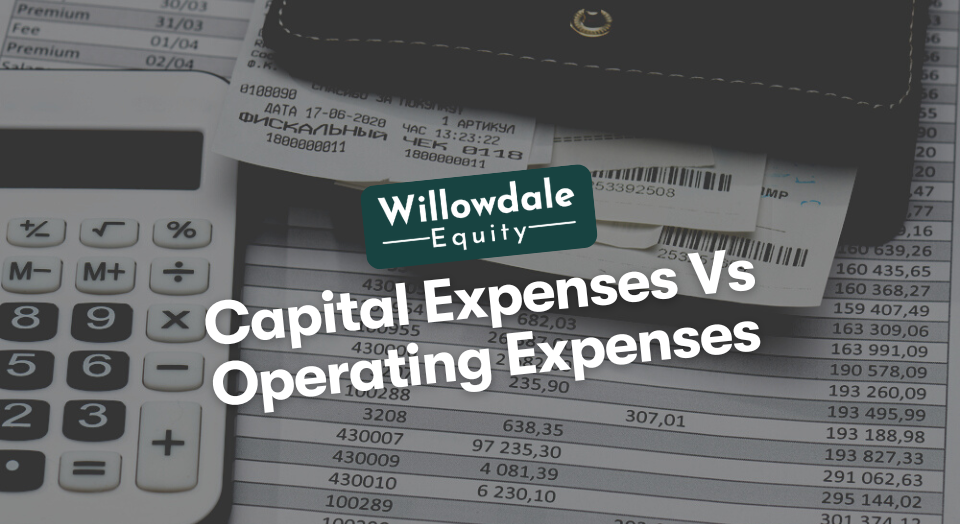
What is Considered a Capital Expense? – Capital Expenses Vs Operating Expenses
This article is part of our guide on passive investing in multifamily via syndication, available here.
New real estate investors constantly feel overwhelmed by the OpEx vs. CapEx discussion. Although the differences between the two terminologies may appear negligible initially, they significantly affect an investor’s bottom line.
These markers are crucial to a company’s development and growth, which raises a few vital questions: What does a capital expense mean? What does an operating expense mean? And what are the differences and similarities between capital and operating expenses? We answer these questions below, discussing what can be considered a capital expense, where operating and capital expenses overlap, and where they differ.
Key Takeaways
-
A business employs capital expenditures (CapEx) to acquire, maintain, and improve tangible business assets, such as real estate, buildings, equipment, and other physical assets.
-
When made, capital expenses may not be entirely deductible for tax purposes. Large costs, like a building acquisition, typically cannot be written off entirely at once. A tax deduction only applies to depreciation or the proportion of an asset deemed to have been used for a year.
-
CapEx = PP&E + Current Depreciation
What Is Considered a Capital Expense?
A business employs capital expenditures (CapEx) to acquire, maintain, and improve tangible business assets, such as real estate, buildings, equipment, and other physical assets. Businesses frequently use CAPEX to launch new initiatives or make expenditures.
Capital investments in fixed assets can involve the following:
- Fixing a roof (if the roof’s usable life is extended).
- Buying business equipment.
- Constructing a new factory.
Companies make this kind of financial investment to expand the range of their operations or to add some potential economic gain.
For instance, real estate investors might count replacing a rental property’s roof as one of their capital expenses. On a bigger scale, “capital expenditure” may refer to the money spent on everything from a new office building to equipment replacement.
How much a company invests in new and existing fixed assets to operate or grow its business can be determined by looking at CAPEX. To put it another way, a corporation declares any expenditure on its income statement as an expense yet capitalizes or classifies it as an investment on its balance sheet. A corporation must amortize the cost of capitalizing an asset over the asset’s useful life.
You can calculate capital expense using the formula below:
CapEx = PP&E + Current Depreciation
The cash flow from the investment activities section of a company’s cash flow statement is where CapEx can be viewed. An investor or analyst may see CapEx represented as capital investment, purchasing of property, plant, and equipment (PP&E), or purchase expense depending on how different companies showcase CapEx. Another critical question about capital expenses that needs to be answered is whether they are deductible or not.
Related Read: Is Painting Considered Maintenace or a Capital Expense?
Are Capital Expenses Deductible?

When made, capital expenses may not be entirely deductible for tax purposes. Large costs, like a building acquisition, typically cannot be written off entirely at once. A tax deduction only applies to depreciation or the proportion of an asset deemed to have been used for a year.
For example, you cannot deduct expenses such as the entire amount of a property’s $500,000 purchase price from your taxes. The recovery period, or the time over which a property must be depreciated, is anywhere from 27.5 years to 39 years, depending on whether the property is commercial or residential. For example, if 80% of the $500,000 property value was the value of the building as opposed to the land (which land cannot be depreciated), then you can depreciate $400,000 over 27.5 years or $14,545 per year.
The example above has been simplified to make it easy for you to understand the deductibility of capital expenses. Every business owner has a unique tax situation because the tax code is complicated and constantly changing. Before you file your tax return with the internal revenue service or make choices that could affect your taxable profit, you should always speak with a tax professional.
Now that you understand capital expenses well, it’s time to compare capital expenses and operating expenses for similarities and differences.
Capital Expenses vs. Operating Expenses
Capital expenditures, or Capex, are company costs incurred to produce future benefits (i.e., acquiring assets with a useful life extending beyond the tax year). A company might, for instance, purchase new assets, such as structures, machinery, or gear, or it might improve existing facilities to raise its asset value.
Opex, or operating expense, refers to those costs necessary for the regular operation of the business, such as salaries, utilities, upkeep, and repairs. Opex is the cash outlay made by the company to convert its inventory into throughput. Depreciating the equipment and plants utilized in production is also part of operating expenses.
Let’s now look at some key similarities and differences between operating and capital expenses.
The Similarities
Operating expenses and capital expenses are both outlays made by the company. Both are often purchased with cash and could undergo an identical purchasing process. It covers bidding, contracting, legal approval, coordinating payment, and receiving the item purchased.
In distinct ways, CapEx and operating expenses lower a company’s net profitability. When operating expenses occur, they are instantly expensed, whereas CapEx is depreciated.
Companies can also make comparable plans for both sorts of spending. Each category of costs incurred may have its budgeting, projection, long-term strategy, and money manager to handle the preparation and reporting of each, even though they may be monitored separately internally.
The Differences
The expense objective is the primary distinction between capital and operating expenses. The purchase of long-term assets that will create income is made through capital expenditures. Operating expenditures cover the cost of daily operations. The following table shows some of the main differences between capital and operating expenses.
Capital Expense | Operating Expense | |
Accounting Treatment | They cannot be entirely written off in the time they were incurred. Intangible assets are amortized over time, whereas tangible assets are depreciated. | In the fiscal period they were incurred, operational expenses were entirely written off. |
Procurement Involvement | Purchasing merely facilitates product acquisition; it rarely starts to lead the herd. Additionally, the arrangement cycle takes a lengthy time. | Consistently accepting everyday items, minimum inventory levels are maintained. Additionally, it doesn’t require any repair or upkeep expenses. |
In Throughput Accounting | Inventory costs are included in CAPEX. | Opex refers to the cost of converting inventory to throughput. |
In Real Estate Investment | Costs associated with purchasing the property that generates income. | Costs associated with the operation, upkeep, and support of a property that generates income. |
We have covered all bases regarding capital expenses vs. operating expenses. However, a few frequently asked questions (FAQs) regarding capital expenses are to be answered. That is what we will be doing next.
Frequently Asked Questions about Capital Expenses
A company’s investment in fixed, tangible, non-consumable assets, like a building, a machine, or a new enterprise, is known as capital expenditure (Capex).
While operational expenses can be entirely tax-deductible in the year they are incurred, capital expenses must be depreciated or progressively deducted over the years, believed to represent the asset’s useful life.
A capital expense, such as an improvement’s total cost, cannot be written off in the year it was done. Instead, you depreciate the asset, taking a deduction for a part of the expense over the improvement’s useful life. Depreciation is advantageous for capital expenditures because it enables the business to avoid taking a substantial financial impact on the year the asset was purchased.
What Is Considered a Capital Expense – Conclusion
The distinction between CapEx and operating expenses serves as a prime example of how different sorts of expenses can affect your company’s profit and tax condition. You might be asking if one is “better” than the other, given that you are now aware of the distinction between operating and capital expenses.
The answer is that it depends on your business and tax situation. Join the investors club here at Willowdale Equity to learn more about CapEx and OpEx, and access private value-add multifamily real estate investing opportunities.
Sources:
- Investopedia, “CapEx vs. OpEx: What’s the Difference?”
- Investopedia, “Capital Expenditure (CapEx) Definition, Formula, and Examples”
- The Balance, “Operating vs. Capital Expenses: What’s the Difference?”
Interested In Learning More About PASSIVE Real Estate Investing In Multifamily Properties?
Get Access to the FREE 5 Day PASSIVE Real Estate Investing Crash Course.
In this video crash course, you’ll learn everything you need to know from A to Z
about passive investing in multifamily real estate.
We’ll cover topics like earned income vs passive income, the tax advantages, why multifamily, inflation, how syndications work, and much much more!




